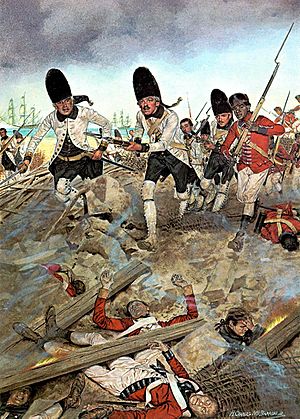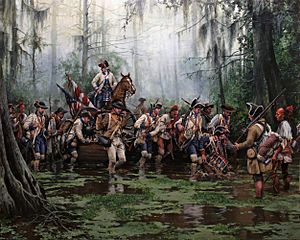Gulf Coast campaign facts for kids
Quick facts for kids Gulf Coast campaign |
|||||||
|---|---|---|---|---|---|---|---|
| Part of the American Revolutionary War | |||||||
 Spanish Troops at Pensacola, Florida by H. Charles McBarron shows a grenadier officer of the Louisiana regiment urging his troops to the assault at Pensacola. |
|||||||
|
|||||||
| Belligerents | |||||||
|
|||||||
| Commanders and leaders | |||||||
|
|
||||||
The Gulf Coast campaign was a series of battles during the American Revolutionary War. It was also known as the Spanish conquest of West Florida. These military actions were mainly led by Bernardo de Gálvez, the governor of Spanish Louisiana. His goal was to fight against the British in their province of West Florida.
The campaign began in 1779 with attacks on British forts along the Mississippi River. This happened shortly after Britain and Spain went to war. Gálvez finished his conquest of West Florida in 1781. He did this by successfully winning the Siege of Pensacola.
Contents
Why the War Started
Spain officially joined the American Revolutionary War on May 8, 1779. King Charles III made a formal declaration of war. On July 8, he allowed his people in the colonies to fight against the British.
Bernardo de Gálvez, the governor of Spanish Louisiana, learned about this on July 21. He immediately started to plan secret attacks. Gálvez had been preparing for war since April. He found out that the British in Pensacola were planning a surprise attack on New Orleans. So, he decided to attack first. He kept the second war announcement a secret from the public.
Battles on the Mississippi River

On August 27, Gálvez began his march towards Baton Rouge. He led a force of 520 regular soldiers, 60 militiamen, and 80 free Black and mixed-race people. Ten American volunteers also joined them. As they marched along the river, more people joined. This included 600 Indians and Acadians.
At its largest, Gálvez's force had over 1,400 people. But many left due to the hard journey. Several hundred were gone before they reached Fort Bute.
At dawn on September 7, Gálvez's force attacked Fort Bute. This fort was an old building from the French and Indian War. Only a small group of soldiers defended it. After a short fight, most of the soldiers surrendered. Six escaped and went to Baton Rouge to tell the British there about the fort's capture.
After a few days of rest, Gálvez moved towards Baton Rouge. It was only about 15 miles (24 km) from Fort Bute. When Gálvez arrived on September 12, he found Fort New Richmond. This fort had over 400 regular army troops and 150 militia. Lt. Colonel Alexander Dickson was in charge. After a nine-day siege, Dickson surrendered.
Gálvez demanded that the British also give up Fort Panmure (modern Natchez, Mississippi). This fort was well-protected and would have been hard for Gálvez to capture. Dickson surrendered 375 regular troops the next day. Gálvez disarmed Dickson's militia and sent them home. Gálvez then sent 50 men to take control of Fort Panmure. He sent his own militia home and left soldiers at Baton Rouge. He returned to New Orleans with about 50 men.
Capturing Mobile
In early 1780, Gálvez started a new plan to capture Mobile. Mobile was one of only two main British military bases left in West Florida. The other was the capital, Pensacola. Gálvez gathered 750 men in New Orleans. He sailed for Mobile on January 11. They reached Mobile Bay on February 9, after being delayed by storms.
On February 20, 450 more soldiers from Havana joined him. But Gálvez did not start the siege until March 1. After 14 days of bombing, Fort Charlotte's walls were broken. Its commander, Captain Elias Durnford, surrendered.
In the fall of 1780, Gálvez tried to capture Pensacola. He launched his ships from Mobile. But a big hurricane scattered his fleet. The damaged ships returned to Havana or New Orleans. So, planning for an expedition in 1781 began again.
British leaders in Pensacola had tried to make West Florida's defenses stronger. This was when war with Spain seemed likely. But there were not many resources. So, General John Campbell, the military commander at Pensacola, could not do much to stop Gálvez. By late 1780, he received some extra soldiers. He also managed to get many local Indians to help defend Pensacola.
When Gálvez's expedition was destroyed, Campbell felt brave enough to try and take Mobile back. In January 1781, he sent over 700 men by land. These men were led by Colonel Johann von Hanxleden. This force was defeated when it attacked one of the Spanish defenses near Mobile. Colonel Hanxleden was killed. This attack caused Spanish leaders in Cuba to send more soldiers to Mobile.
The Siege of Pensacola
Gálvez and Spanish leaders in Cuba launched another attack on Pensacola in February 1781. Gálvez had about 8,000 soldiers. Spanish and French ships helped him. First, they blocked the Pensacola harbor. Then, they began the siege on March 9.
By April 30, the Spanish had cannons in place. These cannons could fully attack Pensacola's main defenses. On May 8, a lucky cannon shot hit the powder storage in one of the outer defenses. The Spanish quickly used this chance to capture the British position. Campbell realized he could no longer hold his position. He started surrender talks the next day. The terms of surrender included all of British West Florida.
See also
 In Spanish: Campaña de la Costa del Golfo para niños
In Spanish: Campaña de la Costa del Golfo para niños

